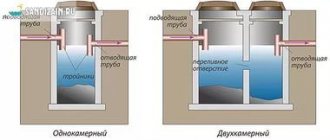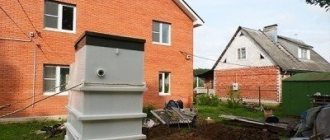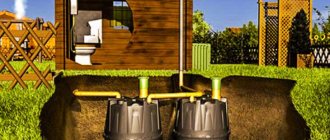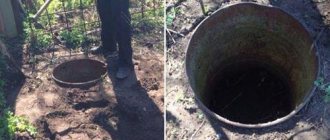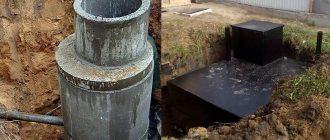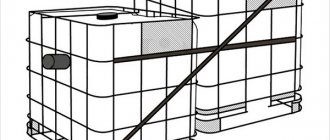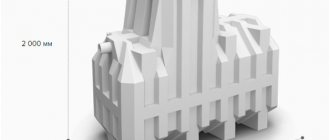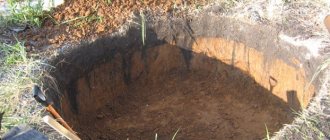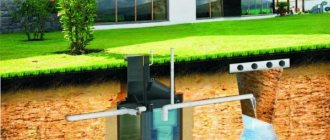If the groundwater level on the site is more than 3 meters, then, as a rule, there are no problems with the installation and operation of the septic tank. But such ideal conditions are not available in all places; in some areas, water begins to appear at a depth of 0.5-1 meters. Construction of a homemade septic tank (made of brick or well reinforced concrete rings) is impossible in such conditions. But sealed industrial installations are allowed to be installed. Let's look at how a septic tank is installed when the groundwater level is high.
Perhaps the most common option for installing an autonomous sewer system is the installation of septic tanks. These devices are used not just to accumulate wastewater, but also to purify it. Therefore, they have to be cleaned much less frequently than storage devices, such as a sealed cesspool.
If previously septic tank chambers were most often made of well rings or other material, today most home owners prefer to purchase ready-made models made of plastic. And one of the most popular industrially produced septic tanks is the Tank.
Myth No. 3: “Pipes must be laid below the freezing depth of the soil”
This is not worth doing. Why don’t sewer pipes freeze, even if they are laid above the freezing depth of the soil?
Reason 1: The pipes remain empty most of the time. Water appears in them when using the sewer system and immediately flows into the septic tank.
Reason 2: warm air from ventilation circulates through the pipes. Ventilation takes warm air from the septic tank, and in the septic tank it appears due to the activity of bacteria.
What happens if you still lay the pipes below the freezing depth of the soil? Minuses:
1) The septic tank will be subject to stronger soil loads and if the septic tank has a small wall thickness, it may simply be crushed.
2) Servicing a septic tank will be extremely inconvenient. Since the septic tank must be periodically maintained, i.e. To pump out water and sludge from all chambers, then directing the hose of a sewer truck through a neck with a diameter of 0.5 m and a height of 1.2 m (or more) to the chambers of the septic tank will be very problematic. The driver of the sewer truck will definitely not say “thank you” to you.
3) The cost of installation work increases significantly.
Pros:
"Septic tank in one day"
The deception is that you not only need to bury one septic tank, but you need an autonomous sewerage system or treatment plant for your home or cottage. As you already know, a septic tank is only part of an autonomous sewerage system or treatment plant. By burying only one septic tank, you will not solve the problem of wastewater treatment and disposal.
We have been building treatment facilities since 1998; in our practice, it has never been possible to build a full-fledged autonomous sewer system for a home in one day. After all, an autonomous sewer system includes: the organization of a sewer outlet from the house, and a sewer line from the house to the septic tank with the organization of cleaning or inspection wells on it, and the installation of the septic tank itself, and, most importantly, the construction of an underground filtration facility for wastewater.
There is a rule in construction: “build quickly, but slowly.”
Of course, when constructing a small treatment plant for a small house using an excavator for excavation work, the construction period can be significantly reduced. Perhaps even up to one day. But in most cases, a construction period of one day is unrealistic for a guaranteed and high-quality solution to the problem of autonomous sewerage.
Myth No. 4: “You need to buy bacteria for the septic tank to work”
Bacteria in a septic tank form naturally, so there is no need to buy bacteria for a septic tank.
What happens if you buy bacteria and add them to the septic tank, and what bacteria is better to buy? It is better to buy bacteria that decompose sediment. Such bacteria decompose sediment at the bottom of the septic tank into water, gas and more solid sediment, which occupies less volume. Therefore, in this case, you can pump out the septic tank less often.
So why, if you can pump out the septic tank less often, shouldn’t you add them? The septic tank should begin to be pumped out when the level of sediment in the first chamber reaches half the water level in the septic tank. With permanent residence and the correct choice of septic tank volume, this will happen after about 1 year of use. It is problematic to measure exactly what level of sediment you currently have at the bottom, so you will not know exactly what effect these bacteria brought, and how much they reduced the level of sediment in the septic tank.
How do you still measure the level of sediment at the bottom? To do this, you need to take a stick and attach a rectangular platform to one end of it. Lower the stick inside the septic tank and rest the platform against the sediment at the bottom, pull out the stick and look at the level mark at which the platform came into contact with the sediment at the bottom.
Source
Septic tank models for 5 people
Septic tank AK ROSTOK Cottage Optima
| More details | Users: up to 5 people Salvo discharge: 1000 l. Processing volume: 1 m3/day Price: 91,300 rub. |
Septic tank TVER 1.2PN
| More details | Users: up to 5-7 people Salvo discharge: 450 l. Processing volume: 1.2 m3/day Price: 121,000 rub. |
Why did the septic tank float up - the main reasons for the septic tank to float up and options for eliminating them
The modern market offers a large selection of septic tanks, and this is an excellent solution for a private home within the city or country house. But what to do if the septic tank floats after installation? What are the reasons for this phenomenon and how to correct the suddenly manifested problem?
How to prevent an accident
The best solution is not to correct problems, but to prevent them already at the septic tank design stage.
Such actions can not only save money, but also save the time and nerves of private sewer owners
The situation when the septic tank surfaced, and the photos presented below became a reality, is very untidy. To prevent this from happening, just follow a few simple rules:
- Choose a set of autonomous sewerage systems “with a reserve”, based on how many people will constantly live and use communications in the house. Choosing a septic tank based on price rather than functionality and capacity is not the best way to save money.
What to do if a septic tank pops up
Regardless of why the septic tank surfaced, its owner has only two options:
- Contact the professionals. They will help you fix your autonomous sewer system as quickly as possible and with a quality guarantee.
- Try to solve the problem yourself . Sometimes this even works. But, more often than not, such craftsmen are still forced to turn to third-party organizations, because the solution requires the use of technical means that not everyone has.
A set of measures aimed at eliminating the problem of a septic tank floating up includes:
- Determining the cause of the problem (incorrectly selected model, high groundwater level, incorrect operation, etc.).
- Removing a floating septic tank with its preliminary emptying.
- Drawing up a project for re-installation. Additional fastenings or anchoring may be required to prevent the septic tank from resurfacing.
- Repairing supply lines. In most cases, squeezing out the main local sewerage reservoir to the surface is accompanied by damage to the inlet and outlet pipes connecting the septic tank to the residential building.
Source
Biological treatment stations are not a septic tank
Often, under the guise of a septic tank, they want to sell you an aeration unit, a biological treatment station and other devices that have nothing to do with a real septic tank. The term “septic tank” is very common and popular among buyers, which is why some sellers of aeration systems usually call their products a septic tank.
The fact is that the septic tank, as a structure, has a history of more than a century and is used in almost all civilized countries of the world. It has been studied thoroughly by many generations of scientists and specialists; there are regulations and standards for its design and construction.
A septic tank, unlike various aeration and biological treatment plants, is always energy independent, simple in design and unpretentious in operation.
In our country and in other civilized countries of Europe and North America, septic tanks are the most common element of autonomous sewerage in ultra-small treatment plants.
Unlike septic tanks, biological treatment stations have not been studied as thoroughly as septic tanks and, as an element of an autonomous sewage system for a country house, have an ambiguous reputation among experts.
What to do if a septic tank tank floats on the property?
If the groundwater level on the site is more than 3 meters, then, as a rule, there are no problems with the installation and operation of the septic tank. But such ideal conditions are not available in all places; in some areas, water begins to appear at a depth of 0.5-1 meters. Construction of a homemade septic tank (made of brick or well reinforced concrete rings) is impossible in such conditions. But sealed industrial installations are allowed to be installed. Let's look at how a septic tank is installed when the groundwater level is high.
Perhaps the most common option for installing an autonomous sewer system is the installation of septic tanks. These devices are used not just to accumulate wastewater, but also to purify it. Therefore, they have to be cleaned much less frequently than storage devices, such as a sealed cesspool.
If previously septic tank chambers were most often made of well rings or other material, today most home owners prefer to purchase ready-made models made of plastic. And one of the most popular industrially produced septic tanks is the Tank.
Septic tank models for 4 people
Septic tank ROSTOK Countryside
| More details | Users: up to 4-5 people Salvo discharge: 2400 l. Processing volume: 0.88 m3/day Price: 46,900 rub. |
Septic tank AK ROSTOK Country Lux
| More details | Users: up to 4-5 people Salvo discharge: 900 l. Processing volume: 0.9 m3/day Price: 91,300 rub. |
Which septic tank should you choose if the groundwater is high?
When installing any model of septic tank, it is imperative to take into account such a characteristic as the groundwater level. If the water is low (depth of more than 3 meters), there are no restrictions when choosing models.
You can purchase a ready-made septic tank and build it yourself from any material. But if the location of groundwater is high, then the choice will be greatly limited. You should immediately discard those varieties whose chambers do not provide 100% tightness.
Septic tank models for 15 people
Septic tank TOPAS 15
| More details | Users: up to 15 people Salvo discharge: 830 l. Processing volume: 3 m3/day Price: 192 690 |
Septic tank TOPAS 15 Long
| More details | Users: up to 15 people Salvo discharge: 850 l. Processing volume: 3 m3/day Price: 220 590 |
Features of installation with periodically rising water mains
Septic tanks are usually installed in the summer. During the hot period of the year, groundwater level is usually minimal. But in the spring, when the snow begins to actively melt, the owners can expect an unpleasant surprise in the form of a pop-up septic tank.
When the groundwater level begins to rise, the septic tank, obeying the well-known force of Archimedes, will simply be pushed out of the soil to the surface.
Advice! It should be remembered that a plastic septic tank is essentially a large float. The chambers of a normally operating septic tank are never filled to the top; approximately a third of the volume of the body is occupied by air.
But even if the installation does not rise above the soil surface, the operation of the system will be disrupted. After all, even with a slight increase in the level of the septic tank (for example, by 5-10 cm), the tightness of the connection between the installation body and the inlet and outlet pipes will be broken.
And this will lead to the flow of wastewater into the ground, which will have a detrimental effect on the ecology of the site. But even if the connection does not collapse during lifting, the system will still not be able to work normally, since the angle of inclination of the sewer pipe will be changed.
How should a septic tank be installed so that there is no risk of floating?
- Prepare a pit of the required size. The width of the pit should be 25-30 cm larger than the septic tank, that is, after installation there should be a gap between the body and the wall of the pit.
- The bottom of the pit is well compacted, then sand is poured onto it. Layer height – 30 cm.
- A reinforced concrete slab with eyelets for fastening is laid at the bottom. Or you can make a cement screed at the bottom of the pit with anchors placed in the solution for fastening.
- After the screed has completely dried, you can install the treatment plant.
- To anchor the plastic body, bandage straps are thrown through it on both sides, which are attached to the embedded anchors of the slab.
- If the water at the installation site rises high, it is recommended to concrete not only the bottom of the pit, but also its walls, constructing a kind of reinforced concrete “bunker” in which the Tank installation will be installed.
Improper backfilling can also lead to the septic tank being pushed out. As a rule, it is not buried below the soil level, since this is too labor-intensive and irrational. If you backfill with ordinary soil, then in winter the soil will begin to “heave” when it freezes.
These processes are especially pronounced in clay soils. Frosty heaving of the soil can move the hull from its place and the unpleasant consequences will be the same as during the ascent. To avoid troubles, not soil is poured along its edges, but a mixture of cement and sand. This backfill acts as a protective cover and will protect the septic tank from the effects of soil.
What to do if the septic tank still floats?
If anti-floating measures were not used during installation, no one can guarantee that the sewer system will not be destroyed. Having seen that the Tank brand septic tank has surfaced, some owners are trying to get out of the situation by filling its chambers with water.
In fact, if the septic tank has already floated, it is completely useless, since when the installation is raised, the pit under it is filled with soil and sand, which was used for backfilling. So, there is only one way out of the situation: pump out the contents of the septic tank and carry out the installation again.
Of course, this is very costly and extremely inconvenient, since the sewerage system cannot be used for a long time. Therefore, preventive measures should be taken at the installation stage. It is possible to use a septic tank Tank if there is a high groundwater level in the area, but you only need to use a special technology for installing the device itself and the infiltrator.
Source
Septic tank models for 10 people
Septic tank ASTRA 10
| More details | Users: up to 10 people Salvo discharge: 550 l. Processing volume: 2 m3/day Price: 149 000 |
Septic tank BioDeka-10 P-800
| More details | Users: up to 10 people Salvo discharge: 570 l. Processing volume: 2 m3/day Price: 143,000 rub. |

